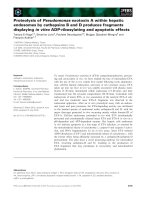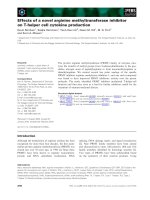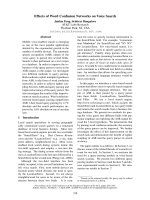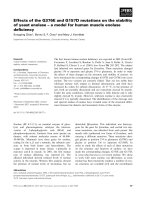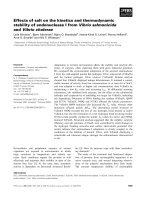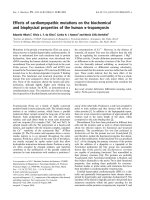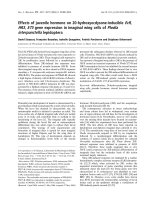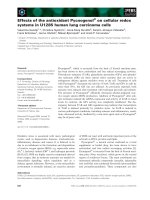báo cáo khoa học: "Effects of an evidence service on community-based AIDS service organizations’ use of research evidence: A protocol for a randomized controlled trial" pptx
Bạn đang xem bản rút gọn của tài liệu. Xem và tải ngay bản đầy đủ của tài liệu tại đây (323.88 KB, 9 trang )
STUDY PROT O C O L Open Access
Effects of an evidence service on
community-based AIDS service organizations’
use of research evidence: A protocol for a
randomized controlled trial
Michael G Wilson
1,2,3*
, John N Lavis
1,2,4,5
, Jeremy M Grimshaw
6,7,8
, R Brian Haynes
4,9
, Tsegaye Bekele
3
and
Sean B Rourke
3,10,11
Abstract
Background: To support the use of research evidence by community-based organizations (CBOs) we have
developed ‘Synthesized HIV/AIDS Research Evidence’ (SHARE), which is an evidence service for those working in
the HIV sector. SHARE consists of several components: an online searchable dat abase of HIV-relevant systematic
reviews (retrievable based on a taxonomy of topics related to HIV/AIDS and open text search); periodic email
updates; access to user-friendly summaries; and peer relevance assessments. Our objective is to evaluate whether
this ‘full serve’ evidence service increases the use of research evidence by CBOs as compared to a ‘self-serve’
evidence service.
Methods/design: We will conduct a two-arm randomized controlled trial (RCT), along with a follow-up qualitative
process study to explore the findings in greater depth. All CBOs affiliated with Canadian AIDS Society (n = 120) will
be invited to participate and will be randomized to receive either the ‘full-serve’ version of SHARE or the ‘self-serve’
version (a listing of relevant systematic reviews with links to records on PubMed and worksheets that help CBOs
find and use research evidence) using a simple randomized design. All management and staff from each
organization will be provided access to the version of SHARE that their organization is allocated to. The trial
duration will be 10 months (two-month baseline period, six-month intervention period, and two month crossover
period), the primary outcome measure will be the mean number of logins/month/organization (averaged across
the number of users from each organization) between baseline and the end of the intervention period. The
secondary outcome will be intention to use research evidence as measured by a survey administered to one key
decision maker from each organization. For the qualitative study, one key organizational decision maker from 15
organizations in each trial arm (n = 30) wi ll be purposively sampled. One-on-one semi-structured interviews will be
conducted by telephone on their views about and their experiences with the evidence service they received, how
helpful it was in their work, why it was helpful (or not helpful), what aspects wer e most and least helpful and why,
and recommendations for next steps.
Discussion: To our kno wledge, this will be the first RCT to evaluate the effects of an evidence service specifically
designed to support CBOs in finding and using research evidence.
Trial registration: ClinicalTrials.gov: NCT01257724
* Correspondence:
1
McMaster Health Forum, Hamilton, Canada
Full list of author information is available at the end of the article
Wilson et al. Implementation Science 2011, 6:52
/>Implementation
Science
© 2011 Wilson et al; licensee BioMed Central Ltd. This is an Open Access article distributed under the terms of t he Creative Commons
Attribution License (http://creative commons.org/licenses/by/2.0), which permits unrestricted use, distribution, and reproduction in
any medium, provided the original work is properly cited.
Background
Community-based organizations (CBOs) are important
stakeholders in health systems [1,2] because they pro-
vide a wide spectrum of programs and services to the
members of their community, link with other health and
social services to help provide care, and advocate for
broader sy stem-level supports. As wit h other health sys-
tem stakeholders (e.g., healthcare providers and health
system managers and policymakers) it is important for
CBOstouseresearchevidencetoinformtheirpro-
grams, services and advocacy. To do this, they need sup-
port in finding and using research evidence to help
them plan and deliver more effective and cost-effective
programs and strengthen health systems.
However, there are many potential challenges related
to research use. Barriers that have been consistently
identified across different sectors include the complexity
of research evidence, organizational barriers, lack of
available time, poor access to current literature, lack of
timely resea rch, lack of experience and skills for critical
appraisal, unsupportive culture for research, lack of
actionable messages in research reports, and limited
resources for implementation [3-7]. Given these barriers,
it is not surprising that, generally, a lack of uptake of
resear ch evidence has been noted in many different sec-
tors [8-12].
While there are strategies for su pporting the use of
research evidence by clinicians [13,14], and health sys-
tem managers and policymakers [15-20], there is still an
important gap in the availability of specific strategies for
CBOs [21]. Many existing strategies for supporting the
useofresearchevidencearebasedonexperienceand
anecdotal evidence rather than on rigorous evidence of
effects [15,22,23]. Moreover, strategies designed for sup-
porting the use of research evidence by healthcare orga-
nizations and governments may not be relevant to the
specific contexts and capacity of CBOs. To begin to fill
this gap, we have developed an evidence s ervice which
for those working in the HIV sector, which is entitled
‘Synthesized HIV/AIDS Research Evidence’ (SHARE –
see below for a detailed description).
Efforts to facilitate the use of research evidence often
focus on four clusters of knowledge translation activities
(’producer push,’ facilitating ‘user pull,’‘user pull,’ and
‘exchange’ efforts) [24], and the SHARE database pri-
marily fits within two of these strategies. First, SHARE
constitutes an effort to facilitate ‘user pull’ by allowing
users to easily identify relevant synthesized research evi-
dence and access user-friendly summaries when they
identify the need for it. In addition, SHARE also consti-
tutes a ‘producer push’ effort by providing periodic
email updates that h ighlight synthesized research evi-
dence that has been newly added to the database. This
type of activity largely promotes awareness of newly
synthesized research evidence, but it could also have
more direct impact on the use of synthesized research
evidence by profiling systematic reviews that address
issues that CBOs may be grappling with at a particular
time. What SHARE does not i nclude are ‘user pull’
mechanisms (i.e., target audiences incorporating
prompts for research eviden ce in their decision-making
processes and developing their capacity to find and use
research evi dence) or ‘exchange’ efforts, which focus on
the producers and users of researchers building pa rtner-
ships and working collaboratively in the production and
interpretation of research evidence [24].
Objectives
Our objective is to evaluate whether, how, and why this
‘full serve’ evidence service increases the use research
evidence by key decision makers in CBOs as compared
to a ‘self-serve’ evidence service.
Methods/design
We will conduct this trial using a sequential explanatory
mixed methods design [25], beginning with the two-arm
randomized controlled trial (RCT), and then following
up with a qualitative process study to explore the RCT
findings in greater depth. The trial will run for 10
months, which includes a two-month baseline period
where all participants receive the ‘self-serve’ evidence
service, a six-month period where the intervention
group will receive the ‘full-serve’ evidence service and
the control group will continue to receive the ‘self-serve’
evidence service, and a final two-month period where
both groups will receive the ‘ full-serve’ version of
SHARE.
RCT methods and design
Study population and recruitment
Community-based HIV/AIDS organizations in Canada
provide a number of programs and services to people
living with or affected by HIV, which may include pre-
vention initiatives, individual or group counseling/sup-
port, and community outreach and/or education. In
addition, organizat ions in Canada are situated in diverse
geographic settings ranging from dense urban settings
to rural, northern, a nd/or remote settings, with some
focused on specific at-risk populations and/or cultural
or ethnic groups.
We will draw our sample from those organizations
affiliated with the Canadian AIDS Society and from rele-
vant provincial HIV/AIDS networks (e.g.,theOntario
AIDS Network), and send an organizational invitation to
the executive director and management team (if applic-
able). The invitation will indicate that if they are interested
Wilson et al. Implementation Science 2011, 6:52
/>Page 2 of 9
in having their organization participate, access to SHARE
will be provided to all interested staff. Given that SHARE
is currently only provided in English, we will exclude orga-
nizations that do not have at least one key decision maker
who is comfortable participating and corresponding in
English.
To ensure clarity in our study recruitment, we will
outline that consent from the e xecutive director is
required for the organization to participate. We will also
indicate that we require one key organizational decision
maker to fill out a brief survey measuring their intention
touseresearchevidence(seetheOutcomessectionfor
more detail on the survey) on behalf of their organiza-
tion at baseline and again at the completion of the trial.
We will request that the executive director complete the
survey, but will indicate that they can delegate to
another manager provided the manager has a decision-
making role about programs, services, and advocacy,
and provided the manager does not include the conduct
of research among their core responsib ilities. Because
the overall intent of the intervention is t o support the
use of re search evidence in decisions about CBOs’ pro-
grams, services, and advocacy, we deemed it most
appropriate for the executive director (or another man-
ager) to complete the survey because they would have
the most impact on whether research evidenc e is used
to inform decisions.
BasedonthemembershiplistprovidedbytheCana-
dian AIDS Society on their website, there are 120 CBOs
available to draw the sample from. Drawing on previous
experience with this sector, we expect to achieve an
approximate response rate of 70%. To increase our
response rate, the Canadian AIDS Society will send out
an email to all i ts members, encouraging them to parti-
cipate by highlighting the importance of the trial. We
will provide additional incentive to enroll in the trial by
hol ding a draw where we will select three organizations
to receive prizes (gift cards) worth $500, $250 and $100.
Interventions
We will run a two-arm RCT with a ‘full-serve’ evidence
service (SHARE) as the intervention a rm and a ‘self-
serve’ version as the control arm. The co mponents of
each version of SHARE are outlined in Table 1 and
described below.
Intervention arm: ‘full serve’ evidence service
Organizations allocated to this study arm will receive
access to a ‘full-serve’ version of SHARE, which pro-
vides:
1. an online searchable database of HIV-relevant sys-
tematic reviews (retrievable based on a taxonomy of
topics related to HIV/AIDS and open text search -
see Additional file 1: Appendix 1 for the taxonomy
of topics);
2. periodic email updates (at least one per month),
which will profile the types of new reviews recently
added to the database (e.g., the number of Cochrane
reviews) and provide a brief overview of the range of
topics addressed by the new reviews;
3. access to user-friendly summaries produced by us
or by others (when available);
4. links to scientific abstracts;
5. peer releva nce assessments, which involves peri-
odic requests (contained in the single record for
each review) to complete a brief a ssessment of how
useful the information in th e newly a dde d review i s
(one question with a five-point scale - see Additional
file 2: Appendix 2 for additional details) with the
average score posted once an assessment is
completed;
6. an interface for participants to leave comments
(up to 250 characters in length) in the records of
systematic reviews in the database (e.g.,ifapartici-
pant wants to leave a comment indicating the review
was useful and why);
7. links to full-text articles (when publicly available);
and
8. access to workshee ts that help CBOs find and use
research evidence
To provide access to user-friendly summaries (see
component three above) we will provide links to user-
friendly summa ries produced by nine groups (when
available) from around the world:
Australasian Cochrane
Centre (AAC) Policy Liaison Initiative, Database of
Abstracts of Review of Effects (DARE), Effective Health-
care Research Programme Consortium, Evidence AID,
Health Knowledge Network, Health-Evidence.ca, Repro-
ductive Health Library, Rx for Change, and Supporting
Policy Relevant Rev iews and Trials (SUPPORT)
[18,26-34].
Control arm
Organizations allocated to the control group will only be
provided website access to a listing of systematic reviews
that are organized by year of publication with links to
the record on PubMed (or another p ublicly available
source when not ava ilable on PubMed) and access to
worksheets that help CBOs find and use research
evidence.
Randomization
After consenting to participate in the trial, we will use
simple randomization to assign organizations to receive
either the ‘full-serve’ or the ‘self-serve’ evidence service.
The list of participating organizations will be sent to a
Wilson et al. Implementation Science 2011, 6:52
/>Page 3 of 9
statistician (TB) who will assign a unique ID number to
each organization, conduct the randomization, and keep
both the key linking the organizations to their ID and
the randomization log in a secure password protected
folder at the Ontario HIV Treatment Network to pro-
vide a clear audit trail. We will perform simple randomi-
zation sampling using the SAS SELECTSURVEY
procedure to assign equal numbers of organizations to
the ‘full-serve’ and the ‘self-serve’ groups. The procedure
will be performed with a fixed seed so that the sampling
can be replicated if needed. The statistician will the n
provide the list of unique IDs with the results of the
randomization to t he SHARE database administrator at
the Ontario HIV Treatment Network (external to the
research team) who will provide individuals from each
participating organization with access to the ‘full-serve’
or ‘self-serve’ versions of SHARE. This will require t he
SHARE database administrator to have access to the key
linking the unique IDs to the organizations but it will
remain concealed from the research team.
Prior t o the start of the trial, all organizations will be
requested to provide a list of emails of management and
staff interested in receiving access to SHARE, which will
be provided to the SHARE database administrator at the
Ontario HIV Treatment Network. We will then send bi-
monthly emails to the executive director (or another
delegated staff member for correspondence) to identify
any staff that have either joined or left the organization
in order to accurately track usage at the organizational
level. The SHARE database administrator at the Ontario
HIV Treatment Network will send the updates to indivi-
duals affiliated with organizations with access to the
‘full-serve’ version of SHARE (the updates will be writ-
ten by MGW and checked by the co-investigators). The
statistician (TB) is a member of the study team but will
only be involved with randomization at the start of the
trialandthedataanalysisupon completion of the trial.
Therefore, participants and all investigators except the
statistician (TB) and the SHARE database administrator
will be blinded to group assignment.
Outcomes
Measuring the impact of knowledge transfer and
exchange (KTE) interventions , such as the evidence ser-
vice propos ed here, poses significant challenges as there
is a long chain of factors between a KTE intervention
such as SHARE and the health status of clients of CBOs
or of broader populations [10,35]. For example, it has
been demonstrated that assessing the impact of KTE
interventions on the practice of physicians poses chal-
lenges due to the fact that many factors other than the
practice guidelines or recommendations th at were disse-
minated may influence how practices are changed
[36-38].
Given these constraints, our primary and secondary
outcomes for the trial are proxy measures for research
use. The primary outcome will be a measure of utiliza-
tion that is similar to what Haynes et al.(2006)usedin
their trial of the McMaster Premium Literature Updat-
ing Service (PLUS) [39]. Specifically, we will track utili-
zation at the organizational level by calcula ting the
mean number of logins/month/organization (the total
organizational logins/month will be averaged across the
number of users from each organization) across trial
groups during each of the baseline period, intervention
period, and crossover period. We will also provide
related descriptive measures such as the mean number
of logins/month for different types of positions within
the organization (exe cutive director, manage ment and
staff), the range of logins/month within the organization,
the proportion of organizations with at least one user
accessing the ‘full serve’ and ‘self-serve’ versions of
SHARE each month, the frequency with which systema-
tic review records and relate d resources are accessed (e.
g., URLs to abstracts, user-friendly summaries, and/or
Table 1 Components of the ‘full-serve’ and ‘self-serve’ evidence service
Evidence service components ’Full-serve’
SHARE
’Self-serve’
Control
1. Access to records for HIV-relevant systematic reviews* X X
2. Searchable database - Reviews retrievable using taxonomy of topics related to HIV/AIDS and open
text search
X
3. Email updates highlighting newly added reviews X
4. Access to user-friendly summaries produced by us or by others X
5. Links to scientific abstracts X X*
6. Peer-relevance assessments† X
7. Links to full-text (when publicly available) X
8. Access to worksheets that help CBOs find and use research evidence X X
* The ‘self-serve’ version will be provided as a listing of reviews grouped by year of publication with titles hyperlinked to their scientific abstract.
†Based a 5-point scale that asks how useful the reviews is and through a user-forum provided for each review record.
Wilson et al. Implementation Science 2011, 6:52
/>Page 4 of 9
full-text), and the number of times the email updates to
the ‘full-serve’ group are forwarded.
Each version of the evidence service will be hosted on
the Ontario HIV Treatment Network server and for the
duration of the trial will require a user login that will be
used to link each participant’s identification with their
usage of the evidence service website and to their orga-
nization. SHARE is a new database that is not yet pub-
licly available (it will be upon completion of the trial),
which allows us to evaluate it without participants being
able to gain access from a publicly available site. In
addition, requi ring a user logi n will help protect against
contamination of the intervention and control group.
However, we cannot protect fully against the possibility
of participants from the organizations sharing informa-
tion given that many may collaborate with each other.
For t he secondary outcome, we will use the theory of
planned behavio ur to measure participants’ intention to
use research. The theory of planne d behaviour proposes
a model about how human action is guided [40,41] and
consists of three variables – attitudes (i.e., b eliefs and
judgments), subjective norms (i.e., normative beliefs and
judgments about those beliefs), and perceived beha-
vioural control (i.e., the perceived ability to enact the
behaviour) – that shape the behaviour intentions of peo-
ple, which is subsequently a strong predictor of future
behaviour [41-43]. In Figure 1, we outline the model of
the theory of planned behaviour and map how different
elements of the evidence service ma y affect e ach of the
three variables.
The theory of planned behavi our has been extensively
used and tested in the fields of psychology and health-
care. Systematic reviews conducted in the psychology
field have demonstrated that the theory explains about
39% of the variance in intention and about 27% of the
variance in behaviour [42,43]. A number of studies have
demonstrated the feasibility of producing valid and reli-
able measures of the key theory of planned behaviour
constructs for use with healthcare profes sionals [44-46].
A s ystematic review suggests that the proportion of the
variance in healthcare professionals’ behaviour explained
by intention was similar in magnitude to that found in
the broader literature [47]. With the successful transfer
of the theory from assessments of individuals to assess-
ments of h ealthcare professionals invo lved in an a gency
relationship with their patients, we are confident in its
further transfer to key decision makers in CBOs in
agency relationships with other decision makers and
staff in their organization.
Using a manual to support health researchers who
want to construct measures based on the theory [41],
our colleagues have developed and sought pre liminary
Attitudes (behavioural beliefs x
outcome evaluations)
Q4a: Using it is beneficial/harmful
Q4b: Using it is good/bad
Q4c: Using it is
pleasant/unpleasant
Q4d: Using it is helpful/unhelpful
Subjective norms (normative beliefs x
motivation to comply)
Q5: People who are important to me
think that I should/should not use it
Q6: It is expected of me that I use it
(agree/disagree)
Q7: I feel under social pressure to
use it (agree/disagree)
Q8: People who are important to me
want me to use it (agree/disagree)
Perceived behavioural control (control
beliefs x influence of control/beliefs)
Q9: I am confident I could use it
(agree/disagree)
Q10: For me to use it is
easy/difficult
Q11: The decision to use it is beyond
my control (agree/disagree)
Q12: Whether or not I used it is
entirely up to me (agree/disagree)
Behavioural intentions
Q1: I expect to use it
Q2: I want to use it
Q3: I intend to use it
Elements for both intervention and
control groups
Access to records for HIV-
relevant systematic reviews
(facilitating pull)
Links to scientific abstracts
(facilitating pull)
Intervention element 1
E-mail alerts
(push)
Intervention elements 2
Searchable database –
retrievable using a taxonomy
of topics related to HIV/AIDS
or using an open search
(facilitating pull)
Access to user-friendly
summaries produced by us or
by others
(facilitating pull)
Peer-
relevance assessments
(facilitating pull)
Links to full-text article
when
publicly available
(facilitating
pull)
Behaviour
Figure 1 Linkages among the intervention, contextual developments, and theory of planned behaviour constructs.
Wilson et al. Implementation Science 2011, 6:52
/>Page 5 of 9
feedback on a data-collection instrument by first asses-
sing face validity through interviews with key informants
and then pilot testing it with 28 policymakers and
researchers from 20 low- a nd middle-income countries
who completed it after participating in a KT interven-
tion [48]. In addition, Boyko et al. (2010) found moder-
ate test-retest reliability of the instrument using
Generalizability Theory (G = 0.50) [49] when scores
from a sample of 37 health system policymakers, man-
agers, professionals, citizens/consumers, and researchers
participating in stakeholder dialogues convened by the
McMaster Health Forum were generalized across a sin-
gle administration, and even stronger reliability (G =
0.9) when scores were generalized acr oss the average of
two administrations of the tool [48]. In the reliability
assessment by Boyko et al. (2010), the first administra-
tion of the tool immediately followed a McMaster
Health Forum stakeholder dialogue, which may have
promoted enthusiasm for using research evidence
among participants. This lik ely produced higher mea-
sures of intention on the first administration of the tool
as compared to the second, resulting in the lower G-
score. Given that we won’t be administering the tool in
a similar atmosphere of enthusiasm for using research
evidence, it is likely that the level of reliability of the
tool will be sufficient without two administrations at
both baseline and follow-up.
We have slightly modified the wording in each of the
questions of the tool to reflect the different intervention
being tested (SHARE) and the target audience (CBOs)
(see Additional file 3: Appendix 3). We will administer
the instrument to one key decision maker from each
organization during the baseline period, as well as at the
end of the six-month intervention period, through a
brief online survey that takes approximately 10 minutes
to complete. We will use unique identifiers for each par-
ticipa nt to ensure their responses to the previous survey
are linked for calculations of before-and-after changes in
their intention to use research evidence. We will follow
up with participants who do not complete the survey
once per week for three weeks to minimize the number
of participants lost to follow up.
Data management and analysis
Data will be entered into SPSS 16.0 using unique identifiers
that link each participant to their respective organizational
identifier assigned during the randomization process. Ana-
lyses will be conducted by two members of the team
(MGW and TB) and, during the analysis, all i nvestigators –
except for one of us who is involved in the both the analy-
sis and randomization (TB) – will be blinded to the key
linking t he organizations t o their unique identifiers.
We will treat both outcome m easures as continuous
variables and analyze the change in these measures over
time using a two-way mixed effects linear repeated mea-
sures analysis of variance (ANOVA), which will assess
the effects within groups, between groups, and over
time with the latter as t he main f eature of interest. In
addition, we will control for four variables – province
the organization is located in, size of organization (as
measured by number full-t ime equivalent staff in the
organization), number of participants that participated
from each organization, and the number of clients
served each year by the organization – using analysis of
covariance. For the analysis of the secondary outcome,
we will also control for whether the key decision maker
is full-time or part-time, and whether they have had
research training in the past. Each of these variable s
may at least partially explain research use (e.g.,the
amount of staff support an executive director or man-
ager has may determine the extent to which they can
spend time finding and using research evidence), and
therefore adjusting for them will allow for a better
assessment o f the effects of the intervention. Moreover,
as part of a secondary analysis, we will assess whether
there is a n interaction between each (entered as fixed
factors) and the outcome measures. Given the likelihood
that the distri bution of the ou tcomes will be skewed, we
will transform the data where necessary and possible,
which may include adjusting the time period for which
we calculate the mean number of logins/month/organi-
zation (e.g., calculating the mean over two months) if
the number of logins is low and there are insufficient
data for analysis. We will also qualitatively compare the
number of participants in the intervention and control
groups that do not complete the follow-up survey, and
attempt to assess if there are reasons for why they
dropped out based on their baseline characteristics.
For all analyses, we will use the intention to treat
principle, report 95% confi dence intervals, and consi der
p-values equal to or less than 0.05 (two-tailed) to be sig-
nificant. For the primary outcome measure (mean
logins/month/orga nization ), missing data are irreleva nt
as they are a naturalistic measure. For the secondary
outcome measure (obtained through the survey), miss-
ing data can be taken into account through the use of a
mixed-effects model.
Statistical precision
Given a fixed sample size of appr oximately 85 organiza-
tions (70% of 120 organizations) a sample size calcula-
tion is not relevant. Instead, we have calculated the level
of statistical precision that we can expec t given our
fixed sample size. To calculate the expected statistical
precision in the trial, an estimation o f intra-class corre-
lation coeffi cient (ICC) of measurements for individuals
over time for the primary outcome is required. How-
ever, we have no mechanism to estimate the ICC due to
Wilson et al. Implementation Science 2011, 6:52
/>Page 6 of 9
the fact that no similar study with this population has
been conducted (at least to our knowledge). Therefore,
we calculated estimates of statistical precision for ICCs
of 0.2, 0.3, 0.5, 0.7 and 0.8 based on a six-month trial
period with 80% power, an estimated standard deviation
of 1.0, significanc e of 0.05 (two-sided test), and 42 orga-
nizations p er study group (total n = 85) [50]. Assuming
the primary outcome data will be collected from all 85
organizations during the intervention period at six fol-
low-up points (one per month), the time-averaged
detectible differences (in standard deviation units)
between the two groups is at best 0.35 (for ICC = 0.2),
which increases with successively greater ICCs to 0.39
(for ICC = 0.3), 0.47 (for ICC = 0.5), 0.53 (for ICC =
0.7), and 0.56 (for ICC = 0.8).
Qualitative methods/design
Given that this is the first RCT evaluating a KTE inter-
vention for CBOs (at least to our knowledge) and the
inherent limitations associated with measuring research
use as an outcome, we will conduct a qualitative process
study after the completion of the trial to explore the
RCT findings in greater depth. The qualitative study will
explore how and why the evide nce service worked (or
didn’twork),determinehowthe‘full-serve’ and ‘self-
serve’ evidence services were used, including the degree
of contamination between the intervention and control
groups, and other factors that may have influenced their
use (e.g., the ease of use of SHARE).
Sample
We will use a mixed method sequential nested sampling
procedure whereby a larger sample is analyzed in one
study (RCT), and a subset of the larger sample is selected
for further inquiry in the second study [51]. Specifically,
one key organizational decision maker from 15 organiza-
tions in each trial arm (n = 30) will be purposively
sampled [52,53]. First, we will divide the organizations
according to whether they received the ‘full-serve’ or ‘self-
serve’ evidence service. Next, we will purposively sample
in order to obtain a breadth of perspective by ensuring
there is a mix with different outcomes from the trial (i.e.,
varying levels of research use and intention to use
research), and with varying size and location within the
country. We have assumed a 70% response rate, which
means that we should sample approximately 40 organiza-
tional key decision makers to achieve a sample size of 30.
Data collection
One-on-one semi-structured telephone interviews w ill
be conducted with key decision makers about their
experiences with the evidence service, including whether
and how they used it (and the degree of ‘contamination’
between the two arms of the RCT, if any) and why,
whether, and how it was helpful in their work and why,
what aspects were most and least helpful and why, and
recommendations for next steps. In addition, we will ask
participants about any recommendations for how to
improve upon our efforts to support the use of research
evidence by CBOs. Finally, for the document analysis,
we will collect all comments pro vided in the user for-
ums for each systematic review record
Data management and analysis
We will tape and transcribe all interviews, use N-Vivo 8
for data management of both the interview transcripts and
document analysis, and use a constant comparative
method for analysis [54-56]. Specifically, two reviewers
will identify themes emerging from each successive wave
of four to five interviews and iteratively refine the inter-
view guide until we reach data saturation. This strategy
will allow the reviewers to develop codes and broader
themes in N-Vivo 8 that reflect the emerging and increas-
ing levels of nuance that will inevitably result from the
continuous checks that are involved in the constant com-
parative method [54,56]. We will also conduct member
checking once analysis is completed (i.e.,wewillsenda
brief, structured summary of what we learned from the
intervie ws and invite comment on it). Finally, we will use
the document analysis of the comments left in the user
forum to help further our understanding of how partici-
pants engaged with the ‘full-serve’ version of SHARE.
Discussion
To our knowledge, this will be th e first RCT to evaluate
the effects of an evi dence service specifically designed to
help CBOs find and use research evidence. As we have
outlined elsewhere [21], efforts to support the use of
research evidence by CBOs have been limited. In addi-
tion, rigorous evaluations of the effects of these strate-
gies remains a critical gap in the KTE literature
[21,24,57]. This study will begin to address this gap by
providing a ri gorous evaluation of the effects of a KTE
intervention for CBOs, and by examining how and why
the intervention s ucceeds or fails. In addition, this trial
will complement a similar RCT we are planning to con-
duct with policy a nalysts and advisors in the Ontario
Ministry of Health and Long-Term Care [58], and will
contribute to an emerging evidence base about similari-
ties and differences in ‘what works’ in KTE across differ-
ent target audiences [13,14,59].
The main limitation of this trial is the relatively small
sample size that we have available to draw upon. How-
ever, while the sample size is relatively small, we are still
reaching an entire sector of CBOs, whic h will help pro-
vide more generalizable results. In addition, through our
partnership w ith the Canadian AIDS Society and their
support with study recruitment, we hope to achieve a
Wilson et al. Implementation Science 2011, 6:52
/>Page 7 of 9
high response rate. Another potential limitation is st udy
contamination between the intervention and control
groups as some participants may collaborate with each
other and share their login and password. To assess
contamination we have included a question in the fol-
low-up survey asking if they shared their login and pass-
word with anyone else outside their organization.
Additional material
Additional file 1: Appendix 1: SHARE (Synthesized HIV/AIDS
Research Evidence) taxonomy of topics. Topics used to categorize
systematic reviews contained in SHARE
Additional file 2: Appendix 2: Peer-relevance assessment question.
Each systematic review record in SHARE asks users to answer one
question about how useful the information is. The results are displayed
to the user after answering the question.
Additional file 3: Appendix 3: Data collection instrument (secondary
outcome measure). A survey measuring participants’ intention to use
research evidence, which will be administered at baseline and at the end
of the trial.
Acknowledgements
The authors thank Lori Chambers, Sergiy Tyshchenko and Mark Ragan and
the Ontario HIV Treatment Network for helping develop the SHARE
database, supporting the study and identifying ways to allow for its
operationalization. We would also like to thank the members of Polinomics
at McMaster University for providing feedback on an earlier draft of the
protocol.
Author details
1
McMaster Health Forum, Hamilton, Canada.
2
Centre for Health Economics
and Policy Analysis, McMaster University, Hamilton, Canada.
3
Ontario HIV
Treatment Network, Toronto, Ontario, Canada.
4
Department of Clinical
Epidemiology and Biostatistics, McMaster University, Hamilton, Canada.
5
Department of Political Science, McMaster University, Hamilton, Canada.
6
Clinical Epidemiology Program, Ottawa Hospital Research Institute, Ottawa,
Canada.
7
Department of Medicine, University of Ottawa, Ottawa, Canada.
8
Institute of Population Health, University of Ottawa, Ottawa, Canada.
9
Health
Information Research Unit, McMaster University, Hamilton, Canada.
10
Centre
for Research on Inner City Health, St. Michael’s Hospital, Toronto, Canada.
11
Department of Psychiatry, University of Toronto, Toronto, Canada.
Authors’ contributions
MGW conceived of the study, participated in its design, and drafted the
protocol. JNL participated in the design of the study and helped draft the
protocol. JG and RBH participated in the design of the study and provided
feedback on drafts of the protocol. TB participated in the design of the
study, performed the sample-size calculations, and provided feedback on
drafts of the protocol. SBR provided feedback on drafts of the protocol. All
authors read and approved the final manuscript.
Competing interests
Three of the authors (MGW, JNL and SBR) were involved in the
development of the SHARE database and remain involved in its continuous
updating. SHARE is the intervention being tested in the trial.
Received: 26 November 2010 Accepted: 27 May 2011
Published: 27 May 2011
References
1. World Health Organization: Ottawa Charter for Health Promotion
Copenhagen: World Health Organization, Division of Health Promotion,
Education & Communication; 1986.
2. World Health Organization: Health 21: Health for All in the 21st Century
Copenhagen: World Health Organization Regional Office for Europe; 1999.
3. Dobbins M, Rosenbaum P, Plews N, Law M, Fysh A: Information transfer:
What do decision-makers want and need from researchers.
Implementation Science 2007, 2:20.
4. Haynes RB, Haines A: Getting research findings into practice: Barriers and
bridges to evidence based clinical practice. BMJ 1998, 317:273-276.
5. Innvaer S, Vist GE, Trommald M, Oxman AD: Health policy-makers’
perceptions of their use of evidence: A systematic review. Journal of
Health Services Research and Policy 2002, 7:239-244.
6. Lavis JN, Davies HTO, Oxman AD, Denis J-L, Golden-Biddle K, Ferlie E:
Towards systematic reviews that inform health care management and
policy-making. Journal of Health Services Research and Policy 2005, 10:
S1:35-S1:48.
7. Mitton C, Adair CE, McKenzie E, Patten SB, Wayne Perry B: Knowledge
Transfer and Exchange: Review and Synthesis of the Literature. Milbank
Quarterly 2007, 85:729-768.
8. Graham ID, Logan J, Harrison MB, Straus SE, Tetroe J, Caswell W, et al: Lost
in translation: Time for a map? Journal of Continuing Education in the
Health Professions 2007, 26:13-24.
9. Grol RP, Dalhuijsen J, Thomas S, Veld C, Rutten G, Mokking H: Attributes of
clinical guidelines that influence use of guidelines in general practice:
Observational study. BMJ 1998, 317:858-861.
10. Lavis JN: Ideas at the margin or marginalized ideas? Nonmedical
determinants of health in Canada. Health Affairs 2002, 21:107-112.
11. McGlynn E, Asch SM, Adams J, Keesey J, Hicks J, DeCristofaro A, et al: The
quality of health care delivered to adults in the United States. New
England Journal of Medicine 2003, 348:2635-2645.
12. Schuster M, McGlynn E, Brook RH: How good is the quality of health care
in the United States? Milbank Quarterly 1998, 76:517-563.
13. Haynes RB, Cotoi C, Holland J, Walters L, Wilczynski N, Jedraszewski D, et al:
Second-Order Peer Review of the Medical Literature for Clinical
Practitioners. JAMA 2006, 295:1801-1808.
14. Haynes RB, Holland J, Cotoi C, McKinlay RJ, Wilczynski NL, Walters LA, et al:
McMaster PLUS: A cluster randomized clinical trial of an intervention to
accelerate clinical use of evidence-based information from digital
libraries. Journal of the American Medical Informatics Association 2006,
13:593-600.
15. Walshe K, Rundall TG: Evidence-based
management:
From theory to
practice in health care. Milbank Quarterly 2001, 79:429-457.
16. Rundall TG, Martelli PF, Arroyo L, McCurdy R, Graetz I, Neuwirth EB, et al:
The informed decisions toolbox: tools for knowledge transfer and
performance improvement. Journal of Healthcare Management 2007,
52:325-341.
17. Lavis JN, Oxman AD, Lewin SA, Fretheim A: SUPPORT Tools for evidence-
informed health Policymaking (STP). Health Research Policy and Systems
2009, 7.
18. Lavis JN: How can we support the use of systematic reviews in
policymaking? PLoS Medicine 2009, 6.
19. Lavis JN, Wilson MG, Hammill AC, Boyko JA, Grimshaw J, Oxman A, et al:
Enhancing the Retrieval of Systematic Reviews that Can Inform Health System
Management and Policymaking (under review) 2011.
20. McMaster Health Forum: Health Systems Evidence. 2011 [http://www.
healthsystemsevidence.org/].
21. Wilson MG, Lavis JN, Travers R, Rourke SB: Community-based knowledge
transfer and exchange: Helping community-based organizations link
research to action. Implementation Science 2010, 5:33.
22. Mitton C, Adair CE, McKenzie E, Patten SB, Waye PB: Knowledge transfer
and exchange: Review and synthesis of the literature. Milbank Quarterly
2007, 85:729-768.
23. Young SK: Evidence-based management: A literature review. Journal of
Nursing Management 2002, 10:145-151.
24. Lavis JN, Lomas J, Hamid M, Sewankambo NK: Assessing country-level
efforts to link research to action. Bulletin of the World Health Organization
2006, 84:620-628.
25. Creswell JW, Plano Clark VL: Designing and Conducting Mixed Methods
Research Thousand Oaks: Sage; 2007.
26. CADTH: Rx for Change. 2010 [ />optimal-ther-resources/interventions/].
27. Centre for Reviews and Dissemination: Database of Abstracts of Reviews
of Effects. 2010 [ />Wilson et al. Implementation Science 2011, 6:52
/>Page 8 of 9
28. Effective Health Care Research Consortium: 2010 [ />evidence/].
29. Cochrane Collaboration: Evidence AID Project. 2010 [hrane.
org/cochrane-reviews/evidence-aid-project].
30. Health-Evidence. 2009 [ />31. Health Knowledge Network: 2010 [ />index.html].
32. Australasian Cochrane Centre: Policy Liaison Initiative. 2010 [http://www.
cochrane.org.au/ebpnetwork/].
33. Supporting Policy Relevant Reviews and Trials. 2010 [http://www.
support-collaboration.org/summaries.htm].
34. The WHO Reproductive Health Library: 2010 [ />35. Lavis JN, Ross SE, McLeod CB, Gildiner A: Measuring the impact of health
research. Journal of Health Services Research and Policy 2003, 8:165-170.
36. Foy R, MacLennan G, Grimshaw JM, Penney G, Campbell M, Grol RP:
Attributes of clinical recommendations that influence change in practice
following audit and feedback. Journal of Clinical Epidemiology 2002,
55:717-722.
37. Grilli R, Lomas J: Evaluating the message: The relationship between
compliance rate and the subject of a practice guideline. Medical Care
1994, 32:202-213.
38. Grol R, Dalhuijsen J, Thomas S, Veld C, Rutten G, Mokkink H: Attributes of
clinical guidelines that influence use of guidelines in general practice:
Observational study. British Medical Journal 1998, 317:858-861.
39. Haynes RB, Holland J, Cotoi C, McKinlay RJ, Wilczynski NL, Walters LA, et al:
McMaster PLUS: A Cluster Randomized Clinical Trial of an Intervention
to Accelerate Clinical Use of Evidence-based Information from Digital
Libraries. Journal of the American Medical Informatics Association 2006,
13:593-600.
40. Ajzen I: The theory of planned behaviour. Organizational Behavior and
Human Decision Processes 1991, 50:211.
41. Francis JJ, Eccles MP, Johnston M, Walker A, Grimshaw J, Foy R, et al:
Constructing Questionnaires Based on the Theory of Planned Behaviour: A
Manual for Health Services Researchers Newcastle upon Tyne: Centre for
Health Services Research, University of Newcastle; 2004.
42. Sheeran P: Intention-behavior relations: A conceptual and empirical
review. In European Review of Social Psychology. Edited by: Stroebe W,
Hewscone M. John Wiley 2002:1-36.
43. Armitage CJ, Conner M: Efficacy of the theory of planned behaviour: A
meta-analytic review. British Journal of Social Psychology 2001, 40:471-499.
44. Bonetti D, Pitts NB, Eccles M, Grimshaw J, Johnston M, Steen N, et al:
Applying psychological theory to evidence-based clinical practice:
Identifying factors predictive of taking intra-oral radiographs. Soc Sci Med
2006, 63:1889-1899.
45. Walker A, Watson M, Grimshaw J, Bond C: Applying the theory of planned
behaviour to pharmacists’ beliefs and intentions about the treatment of
vaginal candidiasis with non-prescription medicines. Family Practice 2004,
21:1-7.
46. Walker AE, Grimshaw JM, Armstrong EM:
Salient beliefs and intentions to
prescribeantibiotics for patients with a sore throat. British Journal of
Health Psychology 2001, 6:347-360.
47. Eccles MP, Hrisos S, Francis J, kaner EF, Dickinson HO, Beyer F, et al: Do self-
reported intentions predict clinicians’ behaviour: A systematic review.
Implementation Science 2006, 1:28.
48. Boyko JA, Lavis JN, Souza NM: Reliability of a Tool for Measuring Theory of
Planned Behaviour Constructs for use in Evaluating Research Use in
Policymaking Hamilton, Canada: McMaster University; 2010.
49. Streiner DL, Norman G: Health Measurement Scales: A Practical Guide to their
Development and Use. 4 edition. New York, USA: Oxford University Press;
2008.
50. Diggle P, Heagerty P, Liang K-Y, Zeger S: Analysis of Longitudinal Data. 2
edition. Oxford, UK: Oxford University Press; 2002.
51. Collins KMT, Onwuegbuzie AJ, Jiao QG: A mixed methods investigation of
mixed methods sampling designs in social and health science research.
Journal of Mixed Methods Research 2007, 1:267-294.
52. Patton M: Qualitative Evaluation and Research Methods Beverly Hills, CA:
Sage; 1990.
53. Sandelowski M: Combining qualitative and quantitative sampling, data
collection, and analysis techniques in mixed-method studies. Research in
Nursing & Health 2000, 23:246-255.
54. Boeije H: A purposeful approach to the constant comparative methods
in the analysis of qualitative interviews. Quality & Quantity 2002,
36:391-409.
55. Creswell JW: Qualitative Inquiry and Research Design: Choosing Among Five
Traditions London: Sage Publications; 1998.
56. Pope C, Ziebland S, Mays N: Qualitative research in health care: Analysing
qualitative data. BMJ 2000, 320:114-116.
57. Mitton C, Adair CE, McKenzie E, Patten SB, Wayne Perry B: Knowledge
transfer and exchange: Review and synthesis of the literature. Milbank
Quarterly 2007, 85:729-768.
58. Lavis JN, Wilson MG, Grimshaw J, Haynes RB, Hanna S, Raina P, et al: Effects
of an evidence service on healthcare policymakers’ use research
evidence: A protocol for a randomized controlled trial. Implementation
Science .
59. Dobbins M, Robeson P, Ciliska D, Hanna S, Cameron R, O’Mara L, et al: A
description of a knowledge broker role implemented as part of a
randomized controlled trial evaluating three knowledge translation
strategies. Implementation Science 2009, 4:23.
doi:10.1186/1748-5908-6-52
Cite this article as: Wilson et al.: Effects of an evidence service on
community-based AIDS service organizations’ use of research evidence:
A protocol for a randomized controlled trial. Implementation Science 2011
6:52.
Submit your next manuscript to BioMed Central
and take full advantage of:
• Convenient online submission
• Thorough peer review
• No space constraints or color figure charges
• Immediate publication on acceptance
• Inclusion in PubMed, CAS, Scopus and Google Scholar
• Research which is freely available for redistribution
Submit your manuscript at
www.biomedcentral.com/submit
Wilson et al. Implementation Science 2011, 6:52
/>Page 9 of 9
